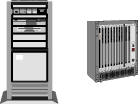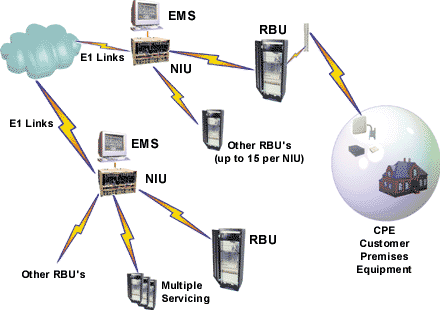|
|
|
|
|
|
|
|
|
|
|
|
|
|
|
|
|
|
|
|||||
|
|
||||||||||
|
|
|
|
|
|
|
|
|
|||
|
|
|
|
| GSM Global Network Solutions' Wireless Local Loop is a radio based, DMA Digital Loop Carrier, that provides a cost effective wireless link between the telecom service provider and subscribers. The system can operate with GSM Handsets/Mobile Units, as well as with GSM compatible Subscriber Units. The system is transparent to the Central Office and subscribers, and interfaces with the most standard Central Office Switches and subscriber telephone equipment. |
 GSM Wireless Local Loop Architecture |
|
Applications
|
The Service Area (Cell) can be any
distance from the Central Office as defined by the location of the
Base Radio Station and Tower. |
|
To cover a larger area, a
"fixed-cellular" approach with frequency reuse can be
employed. |
|
 |
|
|
|
 |
Network Access
|

|
Radio Link |

|
Subscriber Unit |

|
GSM Handset |

|
| The (NAS) system can also be configured
to interface with a low earth orbit (LEO) or geostationary (GEO)
satellite system, terrestrial cellular, or personal communication
service (PCS). This makes the system particularly attractive in
areas where the satellite or cellular service provider is the only
practical access to the public telephone network. | |
CDMA - PrimeWave 2000TM GNS, a world leader in military communications for nearly forty years, uses a revolutionary technology created specifically for wireless local loops - Prime Wave 2000TM - to design CDMA-based wireless local loop solutions. Prime Wave 2000TM is a synchronous code division multiple access (S-DCMA) system based on communications technology developed for international military applications. GNS, a world leader in military communications for nearly forty years, built this leading edge technology on its historical foundations with such companies as Lockheed Martin, Loral, and Unisys. S-CDMA systems have a large network capacity (1:1 frequency reuse), low transmission power requirements (1Wt), a high data transmission rate (from 64 kbec to 256 kbsec), and secure channels. Because of S-CDMA spectral efficiency, systems using this technology have three times the capacity of such conventional CDMA systems as W-CDMA, B-CDMA, or IS-95, so you get maximum return on your limited network resources. By combining the antenna and customer
premises equipment (CPE) in one unit, the system eliminates cable
loss, which can be very high on a GHz frequency band, and therefore
increases coverage and reduces bit error rate. Because the network
interface unit can interface with the telephone network as a class 5
switch, the system is a very powerful and cost-effective solution.
| |
 Benefits Element Management System (EMS) - A PC- or workstation-based operation, administration, maintenance, and provisioning (OAM & P) terminal. Subscriber Unit (SU) - The subscriber's link to Prime Wave 2000TM. A wall or pole mounted antenna with integrated radio electronics that serves one, two, four, or eight independent telephone subscribers. Advanced network services that use the ISDN subscriber unit and the X.21 subscriber unit. Network Termination Unit (NTU) - Small, wall mounted unit that is the connection point for subscriber telephone wiring. Uninterruptible Power Supply (UPS) - A small uninterruptible power supply that interfaces with the primary power from the customer premises and contains the voltage regulators and emergency backup battery. It features SU backup power approximately six hours talk time and microprocessor controlled charging. It reports battery status and AC line power status back to the EMS of the RBU. | |
|
- Profile - Contact
- News - Hungary - Romania
- Auction - Products
- Services - |